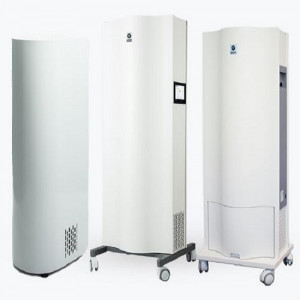| Genano Ltd. |

| Registration Date | 1 Apr 2020 |
| Revision Date | 1 Apr 2020 |
| Share |
Environment Air Remediation
Air PurifierGenano brings additional boost to the current operating theatre ventilation system, if the total ACH does not meet requirements. In this case, the total ACH of the room is determined by the room ventilation rate and the re-circulating Genano air decontamination unit together. Boosting the system ventilation and/or creating a pressurized operating room with Genano is a powerful and cost-effective solution especially in outpatient rooms and elder hospital facilities. Our units are designed to improve the performance of central ventilation as an additional purification system, to provide constant nanoscale contamination control. Easy maintenance and automatic washing system ensure low lifetime running costs, while cleaning efficiency stays high at all times protecting people from airborne pathogens. Genano state-of-the art system is based on electric filtering that removes ultra-fine particles down to 0,3 nm. As the air circulates through the air decontamination unit, all microbes (viruses and bacteria) are killed and removed with an electric shock, removing dangerous gaseous compounds and smells. Our technology does not contain filters that can get clogged, therefore the purification efficiency stays high at all times.
The patented Genano® cold plasma technology eliminates bacteria and viruses effectively.
HEPA filters are commonly utilized to filter supply air flow in a cleanroom. However, it can only collect particles of 0.3 μm and larger in diameter, which renders a need for additional air decontamination technologies such as air purifier units in the room. Majority of nanoparticles in cleanrooms are process-related and must be effectively removed at the source. While most particles in cleanrooms can be related to human activity, ultra fine particles are also generated by electrostatic discharge, chemical reactions such as oxidation, and gas phase nucleation. These contaminants cannot be removed with fixed HVAC interfaced HEPA filtering systems.
Our air purifiers do not contain any easily clogged, regularly replaceable filters, so their performance remains constantly high and they are easy to use – and no replaceable parts means low running costs. The system does not suffer from increase in pressure drop due to accumulation of particle mass, nor does it provide substrate for microbes to grow.
Building cleanrooms with Genano is highly cost-efficient and fast compared to traditional HEPA systems. Only minor piping work is needed to connect the Genano air purifier to central ventilation. All of the supply air enters the room through the unit, while air flow is controlled to create positive pressure difference to outside environment. A second unit is utilized to constantly circulate and purify the air from any process and human-related contaminants.
Genano’s technology not only collects viruses and bacteria like typical air filters, it also kills particles down to a nano-scale, eliminating the risk of contagion from the device itself. Genano Air Decontamination Units equipped with a negative pressure kit, are the fastest and most cost-effective way to rapidly set up isolation rooms – flexibly according to need, as outbreaks like MERS and COVID-19 have proved.
The number of novel coronavirus cases is growing quickly as the real-time tracking map by Johns Hopkins University's Center for Systems Science and Engineering shows us. The data is collected from the US Centers for Disease Control and Prevention, WHO, the European Centre for Disease Prevention and Control, the Chinese Center for Disease Control and Prevention and the Chinese website DXY, which aggregates data from China's National Health Commission and the CCDC.
Genano Air Decontamination Units are a rapid and cost-effective way to set up a cleanroom in Healthcare facilities. With our modular, mobile solution a clean room can be set up where ever needed. It is a cost-effective solution that can be designed to fit any room-specific needs for ACH, pressurization or other demands – where HEPA is not enough. The supply air flow in an operating theatre is commonly filtered by HEPA, which only collects particles of 0.3 μm and bigger in diameter.